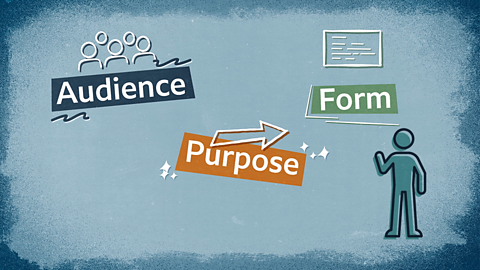Introduction to structure in non-fiction texts
When looking at the effect that writers are trying to have on their reader, it is important not just to look at the language they have chosen to use. You must also look at the structural features of their text, as they have deliberately chosen to use these for effect too.
Video about how to investigate structure
Find out how to investigate structure in non-fiction texts
What is structure?
- Structure is the way a text is organised.
- Structure can mean how the whole text is organised or the organisation of a single paragraph or sentence.
The way a text is structured can affect the readerãs response.

What do we mean by the structure of a text?
The structure of a text is the way that it is organised.
Looking at the whole text
Some types of non-fiction text follow a pattern. You would expect an essay to start with an introduction and end with a conclusion, for example, or a letter to begin by addressing the recipient. But there is much more that you can consider.
When investigating whole text structure, you can look at:
- The order of information. Why has the writer chosen to give the information in this order?
- Shifts in the writerãs viewpoint. Are the writerãs views still the same (or have they changed) as you move through the key points in the text?
- Shifts in the focus. Has the focus changed? For example, shifting from theories to real-life examples.
- Changes in tone. Has the mood and feeling of the text changed as you move through the key points in the text?
A writer can control a textãs whole structure to have a particular impact on the reader. For example:
- A piece of travel writing could be structured so that the tone of excitement or tension builds towards the end.
- An investigative magazine article might be structured around a series of surprising events that keep driving the readerãs interest.
Topic sentences
One of the ways writers structure their text is through the use of topic sentences. Each paragraph in a magazine article, speech or essay, for example, might be ordered around a topic sentence which gives a little taster of what that paragraph will cover.
In former United States President Barack Obamaãs 2008 victory speech, one paragraph begins, ãThis victory alone is not the change we seekã. This is the topic sentence, indicating that the rest of the paragraph will be explaining the kinds of change the new president is hoping for following his victory:
This victory alone is not the change we seek. It is only the chance for us to make that change. And that cannot happen if we go back to the way things were. It can't happen without you, without a new spirit of service, a new spirit of sacrifice. So let us summon a new spirit of patriotism, of responsibility, where each of us resolves to pitch in and work harder and look after not only ourselves but each other.
Identifying changes in tone
Tone refers to the mood of the text that is implied by the writerãs choice of vocabulary, imagery and use of language techniques.
A change in tone is when the mood of the text changes part of the way through for an intended effect.
The way in which you identify a change in tone is to carefully analyse the vocabulary and language techniques the writer is using as the text progresses, so that you can spot when the feeling of their writing changes. You should then ask yourself why the writer has now chosen to present this change in mood. How does it support the ideas and messages the writer is now intending to communicate in this section of the text?
Noticing shifts in focus
A shift in focus happens when what the writer is talking about changes.
For instance, the writer may start by talking about a theory at the beginning of a text. However, half way through they may shift the focus of the text to look at real-life examples with the aim of illustrating the ideas previously stated in the theory.
A writer may shift the focus in order to influence the developing thoughts and ideas that the reader may be having in response to what they have written.
Structural features within paragraphs
Writers also think carefully about how they structure their sentences within each paragraph. It is interesting to look out for any choices they've made with:
- order of words
- sentence length
- punctuation
- repetition
Variations with any of them can affect the meaning and impact of a single sentence.
Order of words
- Appallingly, many factories still use child labour.
- It is appalling that many factories still use child labour.
The structure of the first sentence gives the word 'appallingly' more impact by emphasising it first and therefore stresses the opinion of the writer.
Punctuation
Punctuation can help a writer make their meaning clear. However, punctuation can also affect the impact of a sentence.
- Will our society ever solve this problem?
- Will our society ever solve this problem!
- Will our society ever solve this problemãÎ
Each different piece of punctuation subtly changes the impact of this sentence. For example, the question mark gives the sentence a reflective tone. The exclamation mark gives the sentence a frustrated tone and the ellipsisThe omission of a word or words usually indicated by three dots. suggests uncertainty.
Repetition
Repetition is used when a key word or phrase is said more than once. It helps the writer to put more emphasis on certain ideas over others. For example:
- This is an urgent appeal for help as these animals are in urgent need.
Test your knowledge
Play Bitesize secondary games. gamePlay Bitesize secondary games
Have fun playing science, maths, history, geography and language games.

More on Critical reading
Find out more by working through a topic
- count5 of 5

- count1 of 5

- count2 of 5
